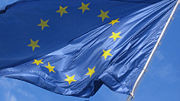PCG Reports on EU Symbols

Flag of the European Union
PCG reported the following this week:
The European Parliament is set to accept a proposal that would dictate the use of the EU flag, anthem and motto for all formal business occasions starting next month. This decision has already been approved by the Parliament’s Constitutional Affairs Committee and is to go before the full house for final approval before the end of the month.
The EU’s flag consists of a circle of 12 golden stars on a blue background; its anthem is “Ode to Joy” from Beethoven’s Ninth Symphony; and its motto is “United in Diversity.”
None of these symbols were included in the text of the Lisbon Treaty for fear they might cause the treaty to be rejected by upsetting national sensibilities. The absence of these symbols was actually the only notable difference between the failed 2005 version of the EU constitution and the Lisbon Treaty that replaced it.
The above is important for several reasons.
The first is that it shows no matter what the European people vote for, those determined to push the EU forward will continue to go forward.
The second is that the flag is in essence, intended to be a veiled endorsement of Catholicism as it is based upon the view that the 12 stars in Revelation 12:1 are supposed to be next to Mary (the fact that there are 27 EU nations and not 12, nor were there even 12 when that flag was developed) is additional reason to understand that Catholicism was the reason it was adopted. Both the flag and the expression “united in diversity” are interesting ways to bring Catholicism (which means universalism) into the EU officially, without actually mentioning religion.
The third is that the song/anthem is an emotional tie for Germany, which to a degree hints of Germany dominance of the EU (even though it will perhaps sometimes have French or other leaders).
And finally, the “United in Diversity” slogan fits perfectly with the biblical indications that there will be an ecumenical religious power coming out the EU. It will apparently be led by a European King of the North who will head up the Beast power–and he is expected by both biblical and Catholic prophecies to endorse a different, temporarily more ecumenical, form of Catholicism.
Officially accepting the “United in Diversity” slogan in October 2008 will fit well when this leader later rises up.
Several articles of related interest may include:
Europa, the Beast, and the Book of Revelation discusses the largest church since the second/third century, which in a real sense is the eighth church mentioned in the Book of Revelation (it also endorses “eighth day” worship). What church would support the Beast?
Who is the King of the North? Is there one? Do biblical and Roman Catholic prophecies point to the same leader? Should he be followed? Who will be the King of the North discussed in Daniel 11? Is a nuclear attack prophesied to happen to the English-speaking peoples of the United States, Great Britain, Canada, Australia, and New Zealand? When do the 1335 days, 1290 days, and 1260 days (the time, times, and half a time) of Daniel 12 begin? When does the Bible show that economic collapse will affect the United States?
Which Is Faithful: The Roman Catholic Church or the Living Church of God? Do you know that both groups shared a lot of the earliest teachings? Do you know which church changed? Do you know which group is most faithful to the teachings of the apostolic church? Which group best represents true Christianity? This documented article answers those questions.
 |
Tweet |
|